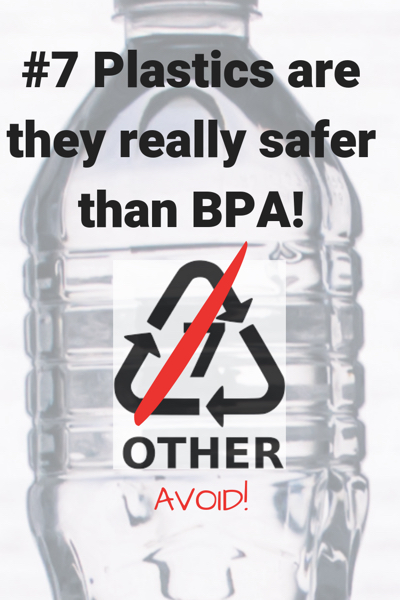 BPA Free Plastic Dangers. Using Safer Plastic
BPA Free Plastic Dangers. Using Safer Plastic
BPA FREE advertising is all the rage, but is BPA free plastic safer? Apparently not! These newer plastics are now proving to be just as unhealthy as BPA, but most consumers are still unaware of this fact.
These “OTHER” plastics are usually marked with a number 7 inside the plastics triangle arrow symbol.
*Important: this triangle arrow symbol does not always mean recyclable! Did you know that you can’t recycle numbers 3, 6 and 7 plastics?
The # 7 plastic can mean any other plastics that isn’t one of the common standard plastics, which are ; PET #1, PET #2, LDPE #4, POLYPROPYLENE #5 and the toxic PVC #3 ( vinyl) & PC #6 ( polycarbonate).
So what are Number 7 Plastics
Number 7 plastics is what is commonly known as “OTHER” plastic.
As it is now common knowledge that BPA plastics is dangerous to our health, plastics manufacturers got clever, they invented alternative plastics!
The problem is that these newer plastics share a very similar chemical structure to a Bisphenol (found in BPA) , hence why they all have a “BP” in their names.
So the above equals, very clever branding and deception!
There are various new-age plastics that come under the #7 and more are being created all the time.
Some of the ones you may come across are; BPAF, BPS,BPP, BPF, BPZ, and BHPF.
BPA FREE Plastic Health Dangers
Scientists are now finding that these new-age alternative plastics may be every bit as unhealthy for us as BPA!
There have been recent animals studies showing these newer plastics alter the chromosomes in the animals. Exposure to the chemicals in these plastics showed that there was problems with the animals bodies combining DNA.
The results being less viable sperm and a decrease in egg quality.
To find out more have a read of this National Geographic article on BPA Free Plastics Safety.
Also read this article by Live Science.
Swap Back To Safer Plastics
So my advice is, if you don’t know what a plastic container is made from, especially one that you prepare or eat food out of, then you have two options;
- Contact the manufacturer and ask for the specs of materials. Specifically the type of plastics used
- Don’t use //buy it and stick to what you know to be safe
Safer Plastics Are
- Polypropylene #5
- Polyethylene #4
- PET #1 and #2 .
With Polypropylene and Polyethylene being the safest.
These safer, 4 plastics are also recyclable!
Before you leave, if you enjoyed this article sign up to LivingSafe and stay informed! LivingSafe helping you live healthier & safer.
Some other natural health and safety articles you may find interesting are:
Toxic PVC Toys How To Avoid Them
Back To School The PVC Free Way
Dangerous Synthetic Air Fresheners And Choosing Safer, Healthier, Natural Options
Keeping Your Home Free of Toxic Air Pollutants
Toxic Chemicals & Fire Retardants In Mattresses Making Us Sick